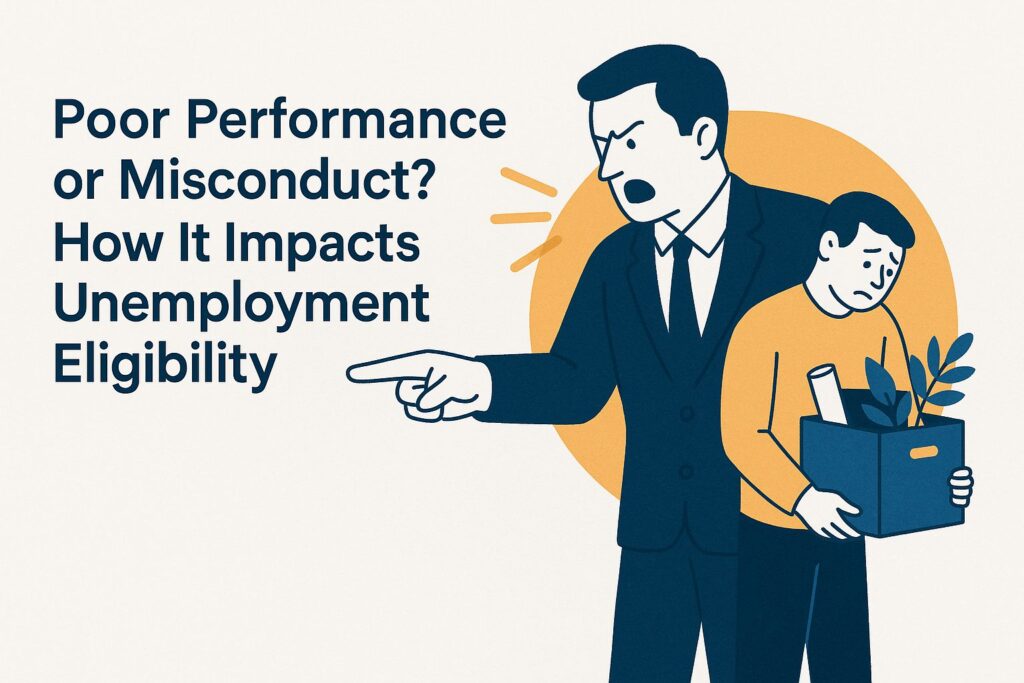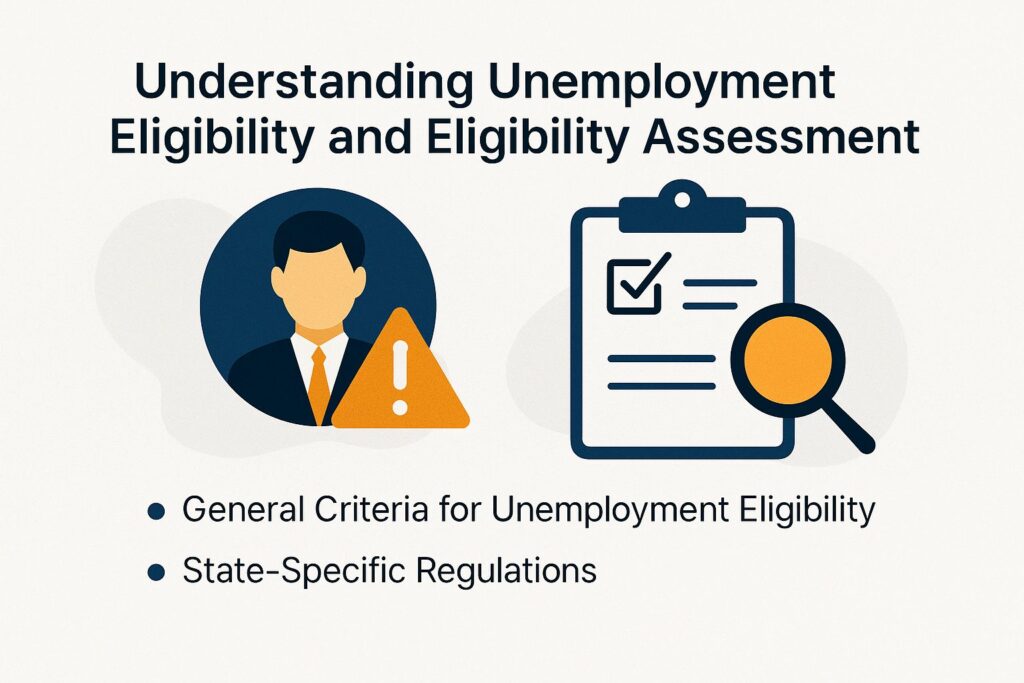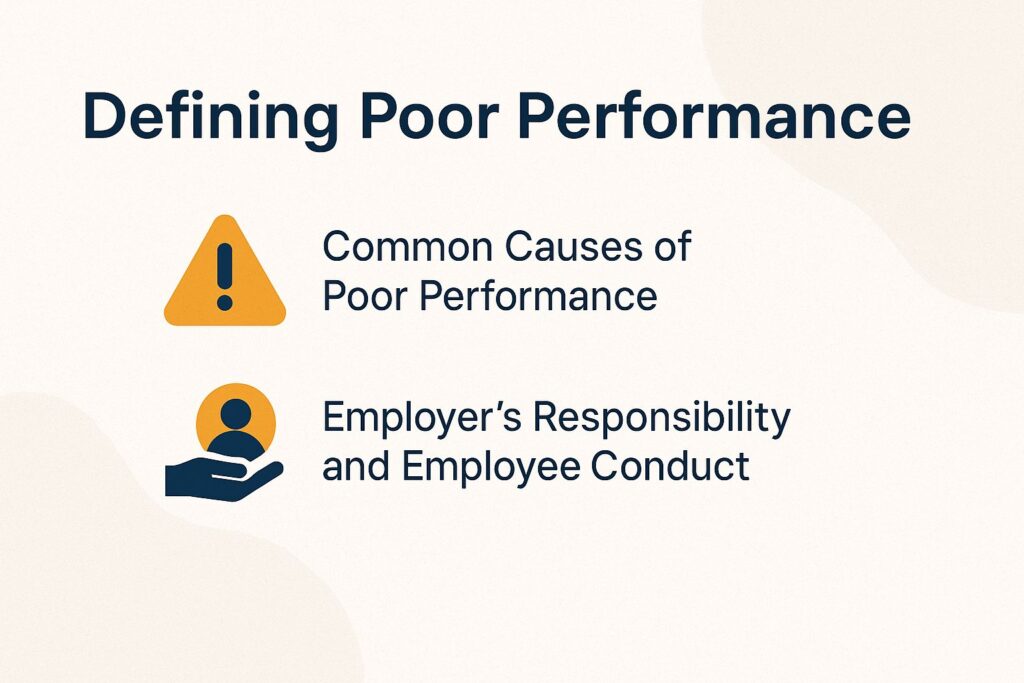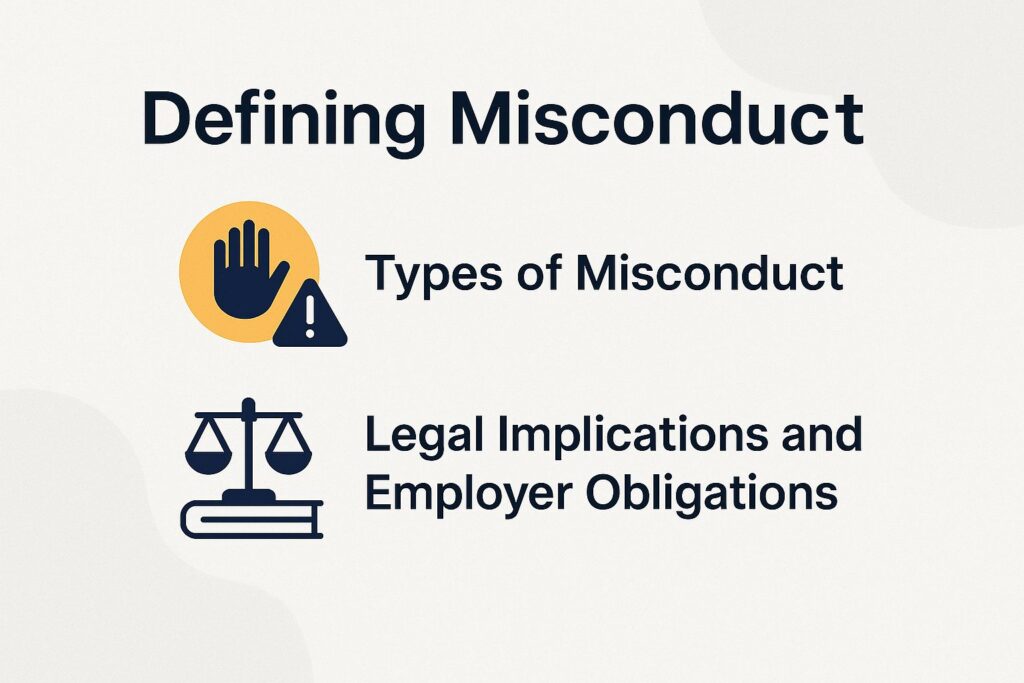
Poor Performance or Misconduct? How It Impacts Unemployment Eligibility
Losing a job can be very tough, but knowing if you can get unemployment benefits is important. It’s important to understand the difference between poor work and misconduct in this process. Figuring out these definitions, looking into state-specific rules, and studying actual cases will clarify how these elements impact your claim. The team at PEOcots.com is here to help you learn more about how your work history can affect your financial security during difficult periods.

Knowing if You Qualify for Unemployment and How It’s Evaluated
Eligibility for unemployment insurance payments varies by state, and each state has specific rules that determine who can receive these benefits.
General Criteria for Unemployment Eligibility
Generally, to qualify for unemployment benefits, individuals must show enough work history, be out of work through no fault of their own, and be looking for new jobs.
Eligibility criteria for unemployment benefits typically include:
- Having worked at least 1,000 hours in the past year;
- Being discharged through no fault of one’s own, such as layoffs;
- Being available for work while actively job hunting.
Weekly benefits often range from $200 to $600, depending on prior earnings, and can last between 12 to 26 weeks. It’s important to review the rules in your state, as they can differ greatly in who qualifies and how much you can receive.
State-Specific Regulations
Each state has unique regulations that can significantly affect unemployment eligibility, including different benefit amounts and job search requirements.
Knowing these differences can help people handle the unemployment claims process better.
For instance, California offers a maximum weekly benefit of $450 for up to 26 weeks but requires a thorough job search with documented efforts.
In contrast, Texas provides a maximum of $535 for 24 weeks, pushing for fewer mandatory job search activities.
New York limits payments to $504 per week and requires more effort in searching for a job, but offers benefits for 26 weeks, the same as California.
Knowing these specifics can guide applicants in tailoring their efforts based on their state’s requirements.
Defining Poor Performance

Poor performance includes actions and results that might result in disciplinary measures or firing, which can affect unemployment eligibility and whether a person qualifies for unemployment benefits.
Common Causes of Poor Performance
Common causes of poor performance include lack of skills, insufficient training, personal issues, and unclear job expectations, which can lead to disciplinary actions and affect job performance.
To handle these problems well, organizations can use specific strategies.
- For skill mismatches, consider launching retraining programs that align employee capabilities with job requirements.
- Tackle personal issues with employee support programs that offer guidance and help.
- Having regular performance reviews can help reduce the problem of not getting feedback by encouraging open discussions about what is expected.
- Job descriptions should be easy to understand, so people know what tasks they need to do.
- To address a lack of motivation at work, put resources into programs that encourage cooperation and raise morale.
Employer’s Duty and Employee Behavior
Employers have a legal and ethical responsibility to provide a conducive work environment and implement performance management systems to support employee development and address performance issues.
To do these tasks correctly, employers should have regular performance reviews, preferably every three months. Constructive feedback mechanisms should be included, allowing employees to understand their strengths and areas for improvement.
Providing opportunities for improvement plans, such as Performance Improvement Plans (PIPs), can help employees correct course. Providing training materials improves learning.
For example, a company that introduced biannual evaluations and improvement plans saw a 20% increase in employee retention, demonstrating the impact of a structured performance management system.
Defining Misconduct

Workplace misconduct involves breaking company rules, which can result in being dismissed, losing access to unemployment benefits, and impacting employee rights.
Types of Misconduct
Misconduct can range from minor rule violations to serious offenses like theft, harassment, and disobedience, which can affect employee rights, job stability, and employer responsibility.
Theft typically leads to immediate termination, stressing its gravity. Harassment can expose employers to legal claims, which may result in further ramifications.
Before deciding on an insubordination issue, it’s important to record and review the employee’s previous actions thoroughly. Substance abuse issues often necessitate a structured rehabilitation plan, reflecting the potential for recovery.
Recent data indicates that roughly 75% of dismissals due to bad behavior happen after documented events. This shows the importance of keeping accurate records to maintain fairness at work.
Legal Implications and Employer Obligations
Misconduct might lead to claims of unfair dismissal and potential lawsuits against companies, impacting their accountability and reputation.
One significant area of risk is wrongful termination lawsuits, as seen in the 2018 case where an employee was awarded $500,000 for being fired after reporting safety violations.
Negligence claims may arise if an employer fails to address wrongdoing, leading to a legal action against the employer. Failing to follow procedures for handling employee complaints can result in legal action.
To handle these risks, employers can get legal advice on labor laws from resources like the Society for Human Resource Management (SHRM) or talk to an employment lawyer.
Impact of Poor Performance on Unemployment Claims
Poor performance can drastically affect unemployment claims, often leading to denials if the employee was terminated for just cause.
To strengthen your appeal after a denial, start by gathering documented performance records that illustrate improvements.
For instance, if you previously received warnings for attendance, compile evidence of reduced absences along with any commendations from supervisors. Highlight specific instances where your performance improved post-warning.
Consider including statements from coworkers or supervisors that support your case.
Successful appeals often hinge on demonstrating a genuine effort to improve, so align your evidence with the claims process guidelines to increase your chances of approval.
Effects of Wrongdoing on Jobless Benefits
When someone loses their job due to bad behavior, it might affect their ability to receive unemployment benefits. Each state has its own rules, but generally, if an employee is fired for misconduct, they may not be eligible for these benefits. It’s important to check the specific regulations in your state to understand how wrongdoing can impact your claim.
Claims of bad behavior can result in immediate loss of unemployment benefits, which can greatly impact an employee’s money matters.
Instant disqualification usually happens for serious offenses like stealing or violence at work. Showing that you are not at fault can be very important in minor cases, such as problems with attendance.
For instance, presenting doctor’s notes or proof of weather-related absences can support your case. Some people have managed to challenge claims of wrongdoing by showing proof of mistakes in the process during their hearings.
Consulting legal advocacy groups can be beneficial, as they offer guidance on documenting your appeal and sharing experiences from past cases.
Case Studies and Examples

Looking at different examples shows the challenges in unemployment claims. It shows claims that are accepted and those denied due to work issues and bad behavior.
Successful Claims
Successful unemployment claims often involve clear documentation of the circumstances surrounding the job loss, such as layoffs or company restructuring.
For instance, an applicant who documents their layoff notice and provides evidence of previous employment is more likely to succeed.
Active job search records, including applications and interview feedback, strengthen the claim’s credibility. Help from previous employers can make the process easier, as a letter confirming the layoff can explain the situation.
Statistics show that more than 75% of claims with these conditions are approved. This highlights the need for detailed paperwork and a proactive job search.
Denied Claims
Claims are frequently rejected due to poor documentation of work performance or allegations of wrongdoing, leading to major financial strain and harm for the affected employees.
- To appeal a denied claim, first, gather all relevant performance reviews, including any positive feedback that may counter the negative assessment.
- Document specific examples where your work met or exceeded expectations. Gather any records of wrongdoing and find differences that could help your case. It’s also beneficial to request statements from witnesses or colleagues who can attest to your performance.
- Writing a complete appeal letter with the necessary documents and clearly stating your position can greatly improve your chances for reconsideration.
By understanding the difference between poor performance and misconduct—and knowing your state’s specific unemployment rules—you can better protect your rights, strengthen your claim, and improve your chances of securing the benefits you need during challenging times.
Written by Carol Sanders
Harvard University graduate with a degree in psychology and human resources.
Owner of a PEO consulting firm in Massachusetts and contributing writer for PEO Costs.


